Initially this guide displays common flowers of all colors that are blooming right now in our area. Use the selectors to view rare species, to view flowers blooming any time, to restrict the output to a certain color, or to search by name.
The Jemez Mountain Herbarium located at PEEC has a specimen collection of over 1,000 plant species that are found in the Jemez Mountain region. This guide was developed as a subset of this collection to help in the identification of the most prevalent flowering plants in Los Alamos County. Most of the plants shown here are native to the area, though a few were introduced to the region.
Monocot and both simple and composite flowering dicots are covered in this guide. This information is included in each description and potentially makes it easier to identify the different plants.
- monocot – seed has 1 embryonic leaf; flower parts com in multiples of 3; leaves have parallel veins
- dicot – seed has 1 embryonic leaves; flower parts com in multiples of 4 or 5; leaves have scattered veins
- simple flower – single, symmetric flowers; usually 3 to 6 petals that emerge from the flower center
- composite flower – multiple, tiny flowers arranged on a single base, typically rays around a disc; each tiny flower has its own seed
Most of the plants represented here are classified as forb/herb which are plants without significant woody growth. However, some flowering shrubs and trees have been included. Many of the later can also be found in the PEEC Tree Guide. This guide does not include any noxious weeds from the area. These are covered in the PEEC Invasive Plant Guide.
You can get additional information on local blooms by joining PEEC Wild Plants. More detailed descriptions can be found in Plants of the Jemez Mountains Volumes 2 and 3, which are available in the PEEC gift shop.
Flower References
American Southwest Plants
Annotated Checklist and Database for Vascular Plants of the Jemez Mountains
Colorado Rocky Mountain Wildflowers
Flora of North America
Foxx, T., Martin, C., and Hoard, D., 2018 Plants of the Jemez Mountains Volume 2: Wildflowers: Showy Monocots and Common Dicots.
Foxx, T., Martin, C., and Hoard, D., 2019 Plants of the Jemez Mountains Volume 3: Composites.
eNature
Lady Bird Johnson Wildflower Center
National Garden Association
Native Plants Society of New Mexico
New Mexico Flora
Rocky Mountain Flora
Southwest Desert Flora
Wildflowers of the United States
US Department of Agriculture Natural Resources Conservation Services
US Forest Service
Subject Area Experts (all guides)
Steve Cary (butterflies)
Beth Cortright (insects)
Terry Foxx (invasive plants)
Leslie Hansen (mammals)
Richard Hansen (fish, mammals)
Dorothy Hoard (butterflies, trees)
Chick Keller (flowers, herbarium)
Shari Kelley (geology)
Kirt Kempter (geology)
Garth Tietjen (reptiles)
David Yeamans (birds)
Web Development and Content Management
Pat Bacha
Jennifer Macke
Graham Mark
Akkana Peck
Contact
Please contact us for local nature questions and sightings. We welcome comments, corrections, and additions to our guides.
For more information about local nature, please visit our Nature Blog or subscribe to PEEC This Week.
Make Selection
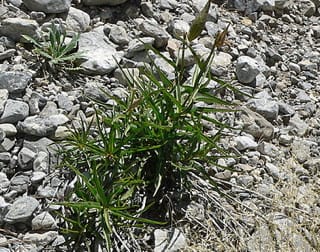 Photo: Stan Shebs 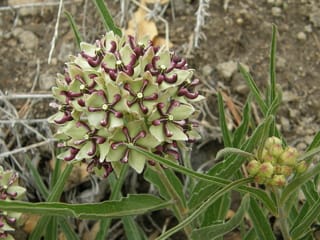 Photo: Chick Keller 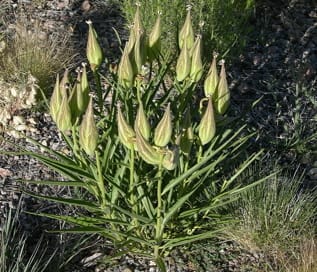 Photo: Jerry Oldenettel | Antelope Horn Milkweed, Spider Milkweed, Green-flowered MilkweedASAS (Asclepias asperula)Family: Apocynoideae (Dogbanes) Size: 12 - 24 in (30 - 61 cm) Growth: forb/herb; perennial Blooms: May 27 - Jul 19 Flower: simple; green and white; spherical flower clusters Leaf: dicot; lanceolate; open, airy network in alternate arrangement Fruit: growing seed follicles resemble antelope horns Status: native; uncommon Habitat: pinyon-juniper, ponderosa --- semi-desert, foothills, woodlands, openings, washes Plant can have either an upright or a sprawling habit. Stems are covered with minute hairs. Info Photos Distribution |
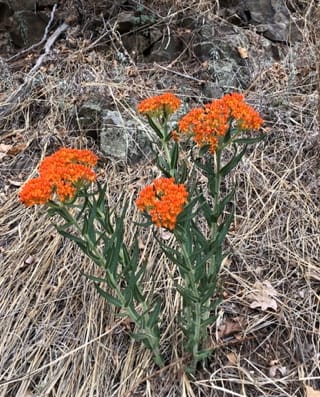 Photo: Christina M. Selby 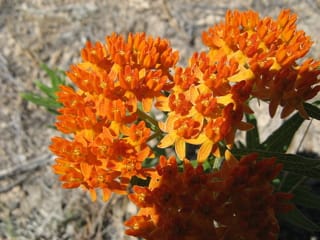 Photo: Janie O'Rourke 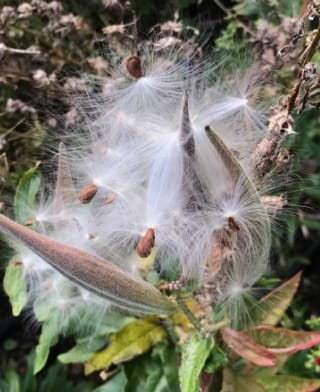 Photo: Sandy Wolkenberg | Butterfly Milkweed, Orange Milkweed, Pleurisy RootASTU (Asclepias tuberosa)Family: Apocynoideae (Dogbanes) Size: 18 - 24 in (46 - 61 cm) Growth: forb/herb; perennial Blooms: Jun 23 - Jul 17 Flower: simple; yellow-orange to bright orange; a showy flowerhead --- large flower cluster at the top of a stem Leaf: dicot; long, pointed, smooth on the edges; mostly alternative spacing Fruit: grayish-green pod covered in short hairs Status: native; rare Habitat: ponderosa --- semi-desert, canyon washes, roadsides Typical location: Upper Crossing Trail into Frijoles Canyon As the name implies, this plant attracts butterflies, in particular, monarchs and queens. Also attracts other pollinators like bumble bees and honey bees. Its tough root was chewed by Native Americans as a remedy for pulmonary ailments. Info Photos Distribution |
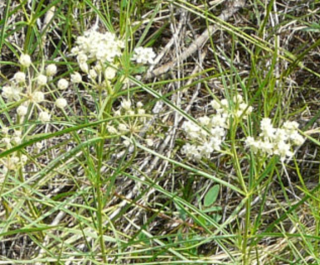 Photo: Becky Shankland 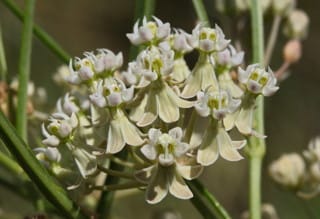 Photo: Craig Martin 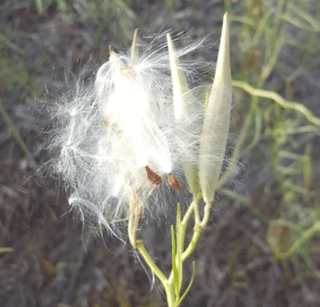 Photo: Alex Abair | Horsetail Milkweed, Poison Milkweed, Whorled MilkweedASSU2 (Asclepias subverticillata)Family: Asclepiadaceae (Milkweeds) Size: up to 40 in (102 cm) Growth: forb/herb; perennial Blooms: Aug 15 - Oct 01 Flower: simple; white and greenish white; small clusters on short stalks; 5 sepals below 5 larger petals Leaf: dicot; long and very narrow; grow in whorls at closely spaced intervals Fruit: long, thin pod-like fruit on a short stem; splits to release fluffy seeds Status: native; common Habitat: disturbed soil --- Seen along road edges. Typical location: White Rock The plant contains a milky sap that is neurotoxic and thus a hazard to livestock. However, it is a host plant for Monarch butterfly larvae and crucial to its survival. The fibers from partially ripe fruit pods have been used for weaving. Info Photos Distribution |
